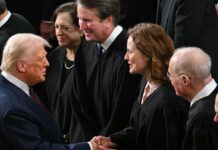
The story so far: Racism lies at the heart of all marijuana prohibition. The man most responsible for making marijuana illegal, former prohibition cop Harry Anslinger, assumed office as America’s first Commissioner of Narcotics in 1930. At the time, he oversaw a patchwork of state-by-state regulations, a small staff, a minimal budget, and equally minimal mandate. Anslinger’s assigned mission, as he began, was the interdiction of opium and cocaine smuggling. Marijuana regulation played no part in it.
At the same time Anslinger was settling in at the nascent Federal Bureau of Narcotics (FBN), the Great Depression was settling in all over America. Money was tight — including for the U.S. government. The lean FBN budget got even thinner. John C. McWilliams, Anslinger’s biographer, wrote in “The Protectors” that at the time, prosecuting drug crimes was simply not high on anyone’s to-do list. The cost to the states and their citizens was too great, especially for a product few knew or cared little about.
Anslinger knew that in order for his bureau to stay viable, it required money and manpower, and he saw that by waging a public relations battle, he might keep the bureau and his power intact.
According to McWilliams, seeing how readily Americans digested stories about marijuana outrages, Anslinger took an aggressive tack: “Instead of minimizing the illicit use of and trafficking in marijuana as he had done for nearly three years, he dramatized the rapid spread of the drug as ‘causing much concern by the Bureau of Narcotics,’ ” and more precisely, “Anslinger manipulated the media” by inventing ‘The Marijuana Myth.’ ”
J. Edgar Hoover was the founding director of the FBI, serving eight presidents. Like Harry Anslinger, Hoover was a determined crime-fighter who also had a penchant for abusing the powers of his office. Both men also craved publicity from high-profile arrests. As a result, Hoover and Anslinger were bitter rivals. (Photo by FBI via Wikimedia Commons)
Anslinger’s rise created friction with the man who had become America’s chief crime fighter, J. Edgar Hoover. The head of the Federal Bureau of Investigation and Anslinger had a rivalry that writer Martin Booth in his book “Cannabis: A History” described as going “to extremes.”
Both men recognized that good publicity was almost as important as money in the budget. Hoover was cautious about the “murky world of narcotics and its potential to corrupt FBI agents” and preferred big arrests of big-name gangsters to raise the FBI’s P.R. profile. Anslinger, Booth said, “was forever seeking to emulate this” which resulted in “much rancor and hatred between the two men and each created his own bête noire to grab headlines and the moral high ground.” In his book, “Reefer Madness: The History of Marijuana in America,” Larry Sloman put it this way “Each felt that there wasn’t enough room for two people like them in the country.”
The men shared a love for gossip — especially when it pertained to wealthy or well-known people. Hoover was notorious for the files he kept on celebrities. As he got more involved in Hollywood, Anslinger also began to accumulate personal information about famous people. McWilliams, in an article titled “Unsung Partner against Crime: Harry J. Anslinger and the Federal Bureau of Narcotics, 1930-1962,” described how Anslinger became aware that a well-known congressman was a morphine addict. Because Anslinger agreed with the congressman’s politics, however, he kept the addiction secret for the rest of the official’s life: Joseph McCarthy. Yes, that Joseph McCarthy.
As this series has described, in addition to being a talented bureaucrat, Anslinger quickly became a master of mythology, too. Booth pointed out that Anslinger used publicity to “[strengthen] the bond between marijuana, crime, and violence. It was compounded by arrested criminals agreeing in their confessions that marijuana had played a part in their crime in the hope of a reduced sentence.” More lies becoming accepted truth.
Of all the stories Anslinger told, one story outshone them all and became the centerpiece of Anslinger’s marijuana mythology: the tragic tale of Victor Licata. On October 16, 1933, Licata, 21 at the time, murdered his family (parents, two brothers and a sister) with an ax while they slept in Ybor City, Florida.
In a 1933 St. Petersburg Times article Licata claims to have been addicted to smoking marijuana for more than six months — the cause, he insisted, for his “unbalanced mind.”
That was all Anslinger needed to hear. Had he actually looked into Licata’s case instead of merely exploiting it, he would have learned that Licata had experienced psychotic episodes long before he ever touched marijuana. Sloman wrote that Licata, in addition to being deemed “criminally insane” by a psychiatrist, was “subject to hallucinations accompanied by homicidal impulses and occasional periods of excitement”, that “His insanity was probably inherited, since the parents were first cousins, his paternal granduncle and two paternal cousins had been committed to insane asylums, and his brother, who was one of the victims, had been diagnosed as suffering from dementia praecox (a term once used to diagnose a sudden onset of psychotic symptoms at a young age).”
There’s bitter icing on the cake: a year before Licata murdered his family, Tampa authorities tried to institutionalize Licata, only to have his family fight them; they insisted at the time that they could better take care of him at home.
Could marijuana have exacerbated Licata’s pre-existing psychosis? That’s not impossible.
All the same, Anslinger made Victor Licata famous, even as Licata hanged himself while institutionalized on December 4, 1950. Anslinger’s public relations instincts would be proven spot on as the Licata story hit its targets: It scared white people and it made them believe Anslinger. In turn, Anslinger cast his eye toward even bigger platforms from which to tell his story, gain more publicity, budget dollars, manpower, muscle, and prestige for the FBN.
When Hollywood itself beckoned, Anslinger happily answered its siren song.
Next installment: Harry Anslinger goes Hollywood and the making of Reefer Madness.”











